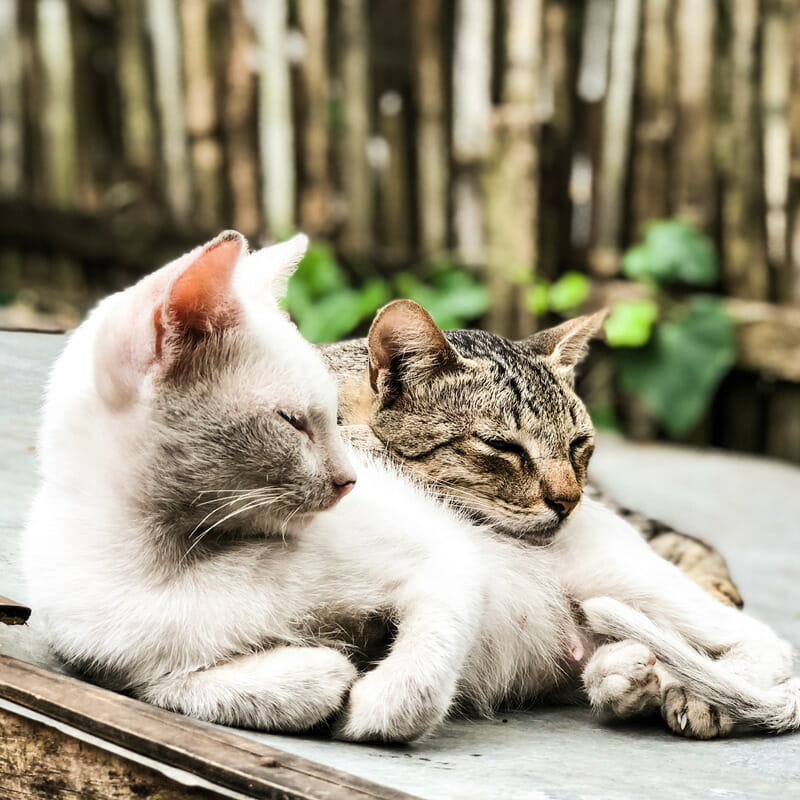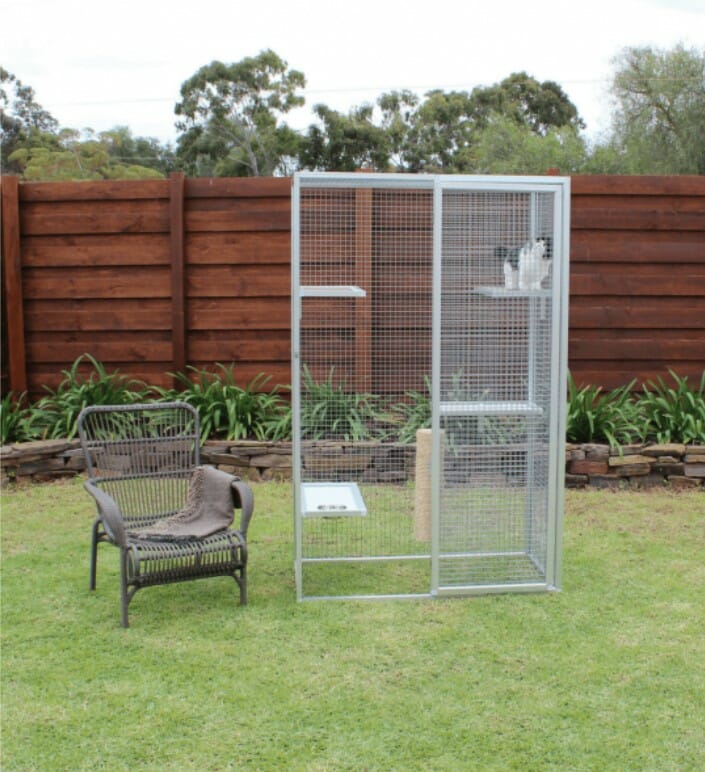House cats are natural predators who love to hunt. Just like their ancestors that lived in the wild, they have agile bodies made for hunting as well as keen senses that help them catch their prey. You’ll see it in the way your cat leaps to catch the feather at the end of the wand toy, or how he energetically pounces on a squeaky ball. Interactive play keeps your cat healthy and happy. It can even prevent behavioural problems that stem from boredom. But aside from regular exercise of at least 10 minutes a day, cats can also be mentally, physically, and emotionally stimulated through other means. This is where a catio comes in!
What is a catio?
Short for cat patio, Animal Planet describes a catio as “an exterior, escape-proof cat house, screened on all sides and overhead, which allows indoor cats to experience a slice of outdoor life without actually venturing beyond your home.” Whether it’s found on your balcony or created on your backyard, a catio gives your house cat the freedom to explore the outside world without you worrying about his safety. The screened enclosure will keep your kitty carefully contained while protecting him from wild predators, free-roaming dogs or cats, moving vehicles, and other possible dangers.
Cats that are curious and playful would enjoy spending time in a catio. Katenna Jones, an associate certified applied animal behaviourist and owner of Jones Animal Behavior, tells PetMD, “If you can never find your cat when you get home with groceries because she’s hiding in a bag with the potato chips, or she gets into your purse all the time, or she comes up to you carrying one of your shoes in her mouth, that cat is a good candidate for a catio.”

What are the benefits of a catio?
A catio can provide daily enrichment for your indoor cat. The secure space lets him take in the fresh breeze, enjoy the warmth of the sun, and/or witness the sights and sounds of nature such as chirping birds sitting atop swaying branches. More than just providing a healthy outdoor lifestyle, a catio can become a safe hideout for territorial cats who need time apart from other household pets. It can also be an additional area where you can place a litter box, therefore reducing unsavoury odours inside your home.
What do I need to consider before building a catio?
Anyone with basic carpentry or home improvement skills can make a catio. However, there are multiple factors you need to evaluate before building one, namely: location, access point, size, and height.
Location
Where should the catio be placed? Consider what you want your cat to observe whenever he steps “outside.” Your catio should provide stimulating views of nature and wildlife and have ample sun and shade—giving him the choice to bask in the sun or to snooze in a shaded spot.
Access point
Think about where kitty will pass through to get to his catio. There should be at least one access point (such as a window, door, or wall) that your cat can freely pass through to and from your home.
Size
How much extra space do you have outside? Is there an existing patio or deck that you can use? How many cats or even hoomans will be using the catio? Are there large accessories you’ll be installing in it? These are a few questions you might want to answer.
Height
The height of your enclosure is also important because most feline pets love vertical spaces. Shelves and perches give your cat the opportunity to survey his territory from up above and escape other land-based creatures. But if you can’t build them, cat trees and hanging shelves work just as well.

What materials do I need to make a catio?
If you plan to build a catio from scratch, you must take time to research on the catio that you want to create. Do you want a long walkway or more perching spots for kitty? How many hiding nooks will there be? Make sure to invest in durable construction materials that can withstand the seasons such as a two-way cat door or flap, wood framing lumber, escape-proof wire, and a weatherproof roof. Jones advises, “Sturdiness is key. You want something that will keep your cat in, but also keep predators out.”
Aside from its basic protective features, a catio won’t be complete without cat accessories that would keep your pet entertained for hours. Carpeted perches, cedar shelves, scratchers, water bowl or fountain, and toys (try making these fun DIY toys) are other essentials you can add to make the catio his new favourite spot. Cat-safe plants such as wheatgrass, thyme, basil, and rosemary will also be a hit for your kitty! (Review this list for toxic plants you should avoid.)
Search for inspiration online to build your own customised catio! You can whip up your own design or purchase downloadable catio plans from Catio Spaces. Choose from a compact, window box-type sitting spot to a bigger, four-sided enclosure with an underground tunnel. The best part is that 10% of each purchase is donated to an animal welfare organisation.

In Australia, you can create your own catio by ordering buildable sets from Backyard Cat Enclosures, Royal Feline, and Catnip Cat Enclosures.


What other things should I keep in mind?
- Once you’ve made your catio, allow your cat to slowly warm up to the new area. Certified cat behaviour consultant and Feline Minds cofounder Mikel Delgado says, “You don’t want to force them. It can take cats a few days or even weeks to test out a new environment, so don’t get discouraged if it takes a while for your cat to adjust.” If your cat doesn’t respond to the catio favourably, you can change some of the components until it strikes his fancy.
- Another thing your cat will need time to figure out is how to use his cat door or flap. You can entice him with treats and toys or initially tape the cat door open so he can stick his head through it to discover what’s outside. Make sure you don’t lock out your cat in the catio or leave him unsupervised for prolonged periods of time, especially when the weather is extreme.
- Though a fresh supply of water comes highly recommended, leaving cat food in the catio is a no-no because it can attract unwanted critters which might try to get into the wired enclosure and harm your cat.
- Build your catio on even flooring that your cat will not be able to dig through and escape from. Stone, grass, and wooden floors are good options, while dirt should be avoided so that your pet doesn’t come into the house with muddy paws. If you’re building a catio above ground, remember to support it with heavy duty angle brackets screwed into your house.
- Put into consideration your cat’s age and personality when you build your catio. Your senior cat might not be able to leap up to high perches like he used to (he would probably need ramps or pet stairs instead), while a more energetic kitten would appreciate toys and shelves placed at different heights.
- Make sure your cat is healthy and has up-to-date vaccinations, deworming, and fecal testing before letting him explore the catio.
Have fun building a catio! Aside from the physical, mental, and emotional benefits a catio will give your cat, building the enclosure will also give you an opportunity to make something fun with your hands, and test your observation skills in putting together the best catio your pet will enjoy. If you throw in a lounge chair or a wooden bench, it can even serve as an open-air space where you and your cat can make more memories together.
Leave a comment
Your email address will not be published. All fields are required.